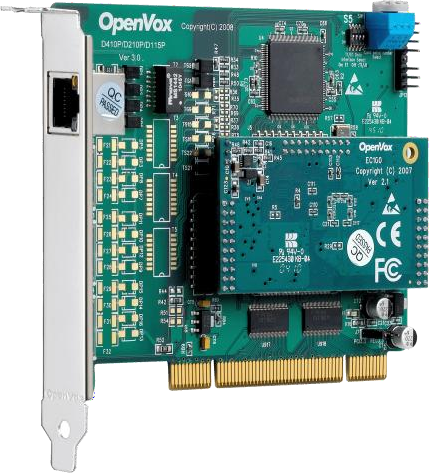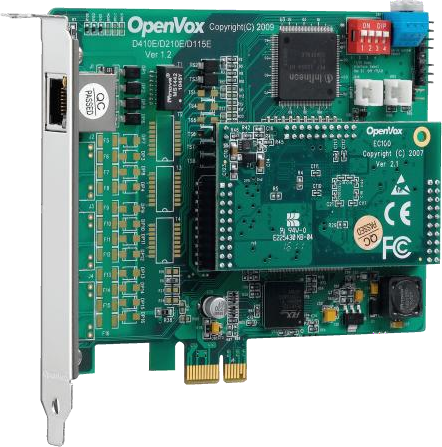DE115P/DE115E on DAHDI User Manual
OpenVox Communication Co.Ltd


DE115P DE115E
DE115P/DE115E on DAHDI User Manual
Version: 2.2
OpenVox Communication Co.Ltd
OpenVox-Best Cost Effective Asterisk Cards
Address: F/3, Building No.127, Jindi Industrial Zone, Shazui Road, Futian District, Shenzhen, Guangdong 518048, China Tel:+86-755-82535461, 82535095, 82535362, Fax:+86-755-83823074
Business Contact: [email protected] Technical Support: [email protected]
Business Hours: 09:00-18:00(GMT+8) from Monday to Friday
URL: www.openvox.cn
Thank You for Choosing OpenVox Products!
Copyright
Copyright© 2011 OpenVox Inc. All rights reserved. No part of this document may be reproduced without prior written permission.
Confidentiality
Information contained herein is of a highly sensitive nature and is confidential and proprietary to OpenVox Inc. No part may be distributed, reproduced or disclosed orally or in written form to any party other than the direct recipients without the express written consent of OpenVox Inc.
Disclaimer
OpenVox Inc. reserves the right to modify the design, characteristics, and products at any time without notification or obligation and shall not be held liable for any error or damage of any kind resulting from the use of this document.
OpenVox has made every effort to ensure that the information contained in this document is accurate and complete; however, the contents of this document are subject to revision without notice. Please contact OpenVox to ensure you have the latest version of this document.
Trademarks
All other trademarks mentioned in this document are the property of their respective owners.
Contents
Chapter 3 Software Installation and Configuration 12
General Safety Instructions

CAUTION
-
-
- The computers that have DE115P/DE115E card installed must comply with the country’s specific safety regulations.
- Only service personnel should go to install DE115P/DE115E card.
- Before installing DE115P/DE115E card, please unplug the power cord and remove the cover from your PC.
- For avoiding personal injuries and damages to your machine and DE115P/DE115E card, make sure bracket of the card is secured to the PC’s chassis ground by fastening the card with a screw.
- Electrical Surges, ESD are very destructive to the equipment. To avoid it, make sure there is a low impedance discharge path from your computer to chassis ground.
- To reduce the risk of damage or injury, please follow all steps or procedures as instructed.
-
Test Environments
CentOS-5.5
Kernel version: 2.6.18-194. el5 DAHDI: dahdi-linux-complete-current Asterisk: asterisk-1.8.5.0
Libpri: libpri-1.4.11.5
Hardware: OpenVox DE115P/DE115E

Chapter 1 Overview
What is Asterisk
The Definition of Asterisk is described as follows:
 Asterisk is a complete PBX in software. It runs on Linux, BSD, Windows (emulated) and provides all of the features you would expect from a PBX and more. Asterisk does voice over IP in four protocols, and can interoperate with almost all standard-based telephony equipment using relatively cost-effective hardware. Asterisk provides Voicemail services with Directory, Call Conferencing, Interactive Voice Response, Call Queuing. It supports three-way calling, caller ID services, ADSI, IAX, SIP, H323 (as both client and gateway), MGCP (call manager only) and SCCP/Skinny (voip-info.org).
Asterisk is a complete PBX in software. It runs on Linux, BSD, Windows (emulated) and provides all of the features you would expect from a PBX and more. Asterisk does voice over IP in four protocols, and can interoperate with almost all standard-based telephony equipment using relatively cost-effective hardware. Asterisk provides Voicemail services with Directory, Call Conferencing, Interactive Voice Response, Call Queuing. It supports three-way calling, caller ID services, ADSI, IAX, SIP, H323 (as both client and gateway), MGCP (call manager only) and SCCP/Skinny (voip-info.org).



![]()
![]()
![]()
![]()




PC+Softphone
Analog phone
Asterisk
VOIP PBX
Switch
SIP phone
Operating System Linux and FreeBSD
OpenSource Drivers Asterisk ®,DAHDI, Zaptel,Bristuff,Misdn and ISDN4BSD
Protocol SIP, IAX, SS7, MGCP, H323, R2 and more.. Applications IVR, CRM, FAX, E-mail, CallCenter, Billing and your application..
Figure 1 Topology
What is DE115P/DE115E
The DE115P/DE115E offers an on-board Octasic® DSP-based echo cancellation module. They support T1, E1, and J1 environments and is selectable on a per-card or per-port basis. The Octasic® DSP-based EC module enables users to eliminate echo tails up to 128ms or 1024 taps across all 32 channels in E1 mode or 24 channels in T1/J1 modes. Further, this module takes advantage of the Octasic® Voice Quality Enhancement to provide superior sound quality on all calls.
DE115P/DE115E supports industry standard telephony and data protocols, including Primary Rate ISDN (both N. American and Standard Euro) protocolfamilies for voice, PPP, Cisco, HDLC, and Frame Relay data modes. Both line-side and trunk-side interfaces are supported.
DE115P/DE115E works well with Asterisk®, Elastix®, FreeSWITCH™, PBX in a Flash, trixbox®, Yate™ and IPPBX/IVR projects as well as other Open Source and proprietary PBX, Switch, IVR, and VoIP gateway applications.
Target Applications
- Voice-over Internet Protocol(VoIP) Services
- Complex IVR Trees
- “Meet-Me” Bridge Conferencing
- Calling Card Platforms
- VoIP Gateways (support SIP, H.323, and IAX)
- Legacy PBX/IVR Services
- Voice/Data Router (replace expensive routers)
- PRI/Switch Compatibility – Network or CPE
Chapter 2 Hardware Setup
There are some points that should be paid attention to when setting up DE115P/DE115E.
Span type setup
Each DIP switch controls one span configuration for E1 or T1.Setting DIP1 to ON means SPAN1 will be E1.Setting DIP1 to OFF means SPAN1 will be T1.
CardID switch setup
If want to install more than one card of DE115P/DE115E in a PC, you should take care of the card ID switch. There are two pieces of rules you must obey:
- The first card must be set to 0, which is a card that will be initialized (i.e. installing driver) firstly when the system boot up. And the second should be set to 1, and so forth.
- At most cases, Linux will initialize PCI devices according to their slot
order. The slot nearest to the CPU will be initialized firstly and the far end slot will be initialized at last. That is to say, the card which is nearest to the CPU ID should be set to 0 if there is more than one DE115P/DE115E on your machine.
Slot compatibility
DE115P is compatible with 32-bit 5.0V PCI slot, 64-bit 3.3V PCI slot or 64-bit 5.0V PCI slot, but DE115E is compatible with PCI-E×1, ×2, ×4,
×8, ×16 slot; you should confirm your slot type and insert into a PCI slot
or PCI-E slot as previously described.
64-bit 5.0V PCI slot
4
64-bit 3.3V PCI slot
3
32-bit 5.0V PCI slot
2
PCI-E ×1 slot
1
Figure 2 PCI-E and PCI slots
Timing cable
If you have just one card in the system, all channels on that card have already run under the same clock source, so timing cable is unnecessary. But if there are more than one card, using timing cable has some advantages. Before using the clock line, each card works on its own clock, therefore precision of the clock is limited; each card will send
/receive voice data at different speeds. In voice usage, this small issue can
be omitted, but in data communication such as Fax/Modem, it will cause
big problems. Data loss will cause communication broken or fax broken. Timing cable will force all cards to work at the same clock source, send data at the same speed, as a result no data will lost.
If you found J914 (input) and J915 (output) interfaces on the card, it
means the card supports clock line, for details, please refer to HERE.
Chapter 3 Software Installation and Configuration
DE115P/DE115P supports DAHDI software driver on Linux. To make full use of DE115P/DE115P, you should download, compile, install and configure Libpri, DAHDI and Asterisk.
Download
DAHDI software packages are available on OpenVox official website or Digium. Some patches should be added while the driver source is from Digium, therefore, it is recommended that downloading the DAHDI driver package from OpenVox official website.
Gain DAHDI source package from OpenVox: http://downloads.openvox.cn/pub/drivers/dahdi-linux-complete/openvox_ dahdi-linux-complete-current.tar.gz
Get Asterisk software package from Digium official website:
http://downloads.asterisk.org/pub/telephony/asterisk/releases/asterisk-1.8
Get libpri software package from Digium official website: http://downloads.asterisk.org/pub/telephony/libpri/releases/libpri-1.4.11. 5.tar.gz
Execute the following commands under the directory of /usr/src/ in
general, the former two below are used for downloading these two packages and the later two are for unzipping them.
# wget http://downloads.openvox.cn/pub/drivers/da hdi-linux-complete/openvox_dahdi-linux-complete-c urrent.tar.gz
# wget http://downloads.asterisk.org/pub/telephon y/asterisk/releases/asterisk-1.8.5.0.tar.gz
# wget http://downloads.asterisk.org/pub/telephon
y/libpri/releases/libpri-1.4.11.5.tar.gz
# tar -xvzf openvox_dahdi-linux-complete-current. tar.gz
# tar –xvzf asterisk-1.8.5.0.tar.gz
# tar –zxvf libpri-1.4.11.5tar.gz
Installation
- Hardware detection
# lspci –vvvv
Check the outcome and confirm your system has recognized
DE115P/DE115E. If it has been recognized, “communication controller” will be displayed in the output information like that:
03:00.0 Communication controller: Unknown device 1b74:0115 (rev 02) Control: I/O- Mem+ BusMaster+ SpecCycle- MemWINV- VGASnoop-
ParErr- Step
ping- SERR- FastB2B-
Status: Cap- 66MHz- UDF- FastB2B- ParErr- DEVSEL=medium
>TAbort- <TAbort
– <MAbort- >SERR- <PERR-
Latency: 32
Interrupt: pin A routed to IRQ 169
Region 0: Memory at fdaff000 (32-bit, non-prefetchable) [size=128]
Figure 3 Hardware detection
If DE115P/DE115E is not recognized by the system, you have to power off and take out the card, then try to insert it into other PCI or PCI-E slot.
Software installation
Some dependencies are crucial. If any of them is absent, the software installation process would not go through successfully. Let’s run “yum install XX” (XX stands for the dependency’s name) to check the availability of dependencies.
# yum install bison
# yum install bison-devel # yum install ncurses
# yum install ncurses-devel # yum install zlib
# yum install zlib-devel # yum install openssl
# yum install openssl-devel # yum install gnutls-devel # yum install gcc
# yum install gcc-c++ # yum install libxml2
# yum install libxml2-devel
 If there is no kernel-devel source in the system, users should run the following command to install the kernel-devel to peer current kernel:
If there is no kernel-devel source in the system, users should run the following command to install the kernel-devel to peer current kernel:
# yum install kernel-devel-`uname –r`
While if there is no matched kernel-devel found, you should download matched RPM package to install it, or execute the following command to update to the latest and stable kernel version:
# yum install kernel kernel-devel
After installed, please reboot your machine to apply the new kernel and install the dependencies. If the dependency has been installed, system indicates that nothing to do which means you could go to next one
directly. Otherwise, the system will keep on installing it.
Among libpri, DAHDI and Asterisk, let’s install libpri firstly, please execute those commands under the directory of /usr/src/ in generally:
# cd libpri-XX # make
# make install
Then change to the directory of dahdi-linux-complete-XX (XX represents DAHDI version), then perform commands one by one to install DAHDI.
# cd /usr/src/dahdi-linux-complete-XX # make
# make install # make config
 Caution: If there is something wrong after “make“, please refer to HERE. In the url link, the moderator introduces you a method how to patch. After patching,
Caution: If there is something wrong after “make“, please refer to HERE. In the url link, the moderator introduces you a method how to patch. After patching,
save your changes and exit. Then run “make” again, if successfully done, it is time for you to install Asterisk.
Please operate those commands to install Asterisk.
# cd asterisk-1.8.5.0 # ./configure
# make
# make install # make samples
 “make samples” will install the standard
“make samples” will install the standard
sample configuration file in the directory /etc/asterisk. As a freshman, you should perform make samples, that is to say,
it is unnecessary to perform make samples every time. Because once performed, it will cover the old sample configuration files you have installed.
Configuration
Driver loading
After compiling and installing DAHDI and Asterisk, please load the driver by running:
# modprobe dahdi
# modprobe opvxd115
# dahdi_genconf
If there is any error, please trace the cause. Until all errors are clear up, you could execute “dahdi_genconf” again, and then go to the next step. By running “dahdi_genconf“, it will generate /etc/dahdi/system.conf and etc/asterisk/dahdi-channels.conf automatically. Checking whether the generated files information agrees with your hardware setup, if not, you should modify to your specific requirements. Do not forget to confirm dahdi-channels.conf is included in chan_dahdi.conf, if not, run command:
# echo “#include dahdi-channels.conf” >>
/etc/asterisk/chan_dahdi.conf
A part of system.conf which is one of the basic channel configuration files is displayed.
# Span 1: D115/D130/0/1 “D115/D130 (E1|T1) Card 0 Span 1” (MASTER)
span=1,1,0,ccs,hdb3,crc4 # termtype: te
bchan=1-15,17-31 dchan=16
#echocanceller=mg2,1-15,17-31
# Global data loadzone = us
defaultzone = us
Figure 4 A part of system.conf
Country mode modification
In order to match your country pattern, you need to change parameters loadzone and defaultzone to your country. For example, your system is in CHINA, you would like them change to:
loadzone = cn defaultzone = cn
 Some zonedata is available in the file
Some zonedata is available in the file
.. /dahdi-XX/tools/zonedata.c, you can refer to it to match your country mode. Meanwhile, you also need to modify another parameter which is in file
/etc/asterisk/indications.conf.
country=cn
A part of file /etc/asterisk/dahdi-channels.conf is showed as below. (Modification, if it is not agree with the hardware setup)
; Span 1: D115/D130/0/1 “D115/D130 (E1|T1) Card 0 Span 1” (MASTER)
group=0,11 context=from-pstn switchtype = euroisdn signalling = pri_cpe channel => 1-15,17-31 context = default group = 63
Figure 5 A part of dahdi-channels.conf
After modifying the country mode, please execute the following command:
# dahdi_cfg –vvvvvv
The command is used for reading and loading parameters in the configuration file system.conf and writing to the hardware. A part of outputs are showed in the following figure.
[root@localhost ~]# dahdi_cfg -v DAHDI Tools Version – 2.6.1 DAHDI Version: 2.6.1
Echo Canceller(s):
Configuration
======================
SPAN 1: CCS/HDB3 Build-out: 0 db (CSU)/0-133 feet (DSX-1)
31 channels to configure.
Setting echocan for channel 1 to none Setting echocan for channel 2 to none Setting echocan for channel 3 to none Setting echocan for channel 4 to none Setting echocan for channel 5 to none Setting echocan for channel 6 to none Setting echocan for channel 7 to none Setting echocan for channel 8 to none Setting echocan for channel 9 to none Setting echocan for channel 10 to none Setting echocan for channel 11 to none Setting echocan for channel 12 to none Setting echocan for channel 13 to none Setting echocan for channel 14 to none Setting echocan for channel 15 to none Setting echocan for channel 16 to none Setting echocan for channel 17 to none Setting echocan for channel 18 to none Setting echocan for channel 19 to none Setting echocan for channel 20 to none Setting echocan for channel 21 to none Setting echocan for channel 22 to none Setting echocan for channel 23 to none Setting echocan for channel 24 to none Setting echocan for channel 25 to none Setting echocan for channel 26 to none Setting echocan for channel 27 to none Setting echocan for channel 28 to none Setting echocan for channel 29 to none Setting echocan for channel 30 to none Setting echocan for channel 31 to none
Figure 6 Channel map
Asterisk initiation
# asterisk –vvvvvvvgc
If Asterisk is already activate, run “asterisk –r” instead. In the CLI, please run the following command:
localhost*CLI> dahdi show channels
| 1 | from-pstn | default | In | Service |
| 2 | from-pstn | default | In | Service |
| 3 | from-pstn | default | In | Service |
| 4 | from-pstn | default | In | Service |
| 5 | from-pstn | default | In | Service |
| 6 | from-pstn | default | In | Service |
| 7 | from-pstn | default | In | Service |
| 8 | from-pstn | default | In | Service |
| 9 | from-pstn | default | In | Service |
| 10 | from-pstn | default | In | Service |
| 11 | from-pstn | default | In | Service |
| 12 | from-pstn | default | In | Service |
| 13 | from-pstn | default | In | Service |
| 14 | from-pstn | default | In | Service |
| 15 | from-pstn | default | In | Service |
| 17 | from-pstn | default | In | Service |
| 18 | from-pstn | default | In | Service |
| 19 | from-pstn | default | In | Service |
| 20 | from-pstn | default | In | Service |
| 21 | from-pstn | default | In | Service |
| 22 | from-pstn | default | In | Service |
| 23 | from-pstn | default | In | Service |
| 24 | from-pstn | default | In | Service |
| 25 | from-pstn | default | In | Service |
| 26 | from-pstn | default | In | Service |
| 27 | from-pstn | default | In | Service |
| 28 | from-pstn | default | In | Service |
| 29 | from-pstn | default | In | Service |
| 30 | from-pstn | default | In | Service |
| 31 | from-pstn | default | In | Service |
Figure 7 channels show
If DAHDI channels are found, it means they have been loaded into Asterisk. You are going to edit dialplan by your requirements.
Dialplan edit
Users must make sure that the context “from-pstn” and “from-internal“
are in extensions.conf. Here a simple example is given:
# vim /etc/asterisk/extensions.conf
[from-pstn]
exten => s,1,Answer() // answer the inbound call exten => s,n,Playback(cc_welcome) //please message exten => s,n,Hangup()
[from-internal]
exten => _X.,1,Dial(dahdi/g0/${EXTEN}) exten => _X.,n,Hangup
Figure 8 dial plan
Additional function
Users should run command “cat /proc/interrupts” to check DE115P has independent interrupt. If it shares interrupt with other device, it may cause some problems even cannot work normally. While DE115P allows users to modify interrupt pin during firmware upgrade for avoiding conflict. Or you can see if the EC module is working as follows:
# dmesg | grep VPM
[root@localhost ~]# dmesg | grep VPM VPM450: echo cancellation for 32 channels
opvxd115 0000:20:00.0: VPM450: hardware DTMF disabled. opvxd115 0000:20:00.0: VPM450: Present and operational servicing 1 span(s)
Figure 9 EC module show
Chapter 4 Reference
www.openvox.cn www.digium.com www.asterisk.org www.voip-info.org www.asteriskguru.com
Tips
Any questions during installation, please consult in our forum or look up for answers from the following websites:
Weight and size
Weight: DE115P /DE115E 76g Size: DE115P 12.9×10.3×1.8cm3
DE115E 13×10.8×1.8cm3
Interfaces
PCI Bus: 3.3V or 5V bus slot, PCI 2.2 or above (DE115P) Any type of PCI-E ×1, ×2, ×4, ×8, ×16 slot (DE115E)
Environments
Temperature Operation: 0 ~50°C Temperature Storage: -65~125°C
Humidity: 10 ~90% NON-CONDENSING
Power consumption
Voltage: 3.3V, 5V
Hardware and software requirements
RAM 128 + MB
Linux kernel 2.4.X or 2.6.X CPU 800+ MHZ
